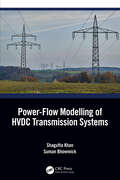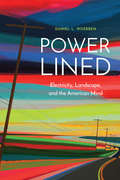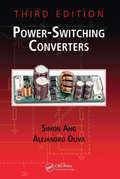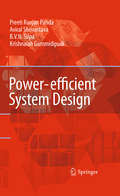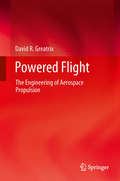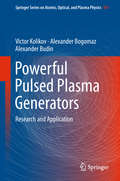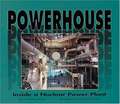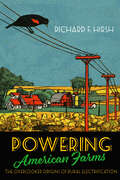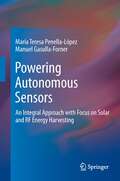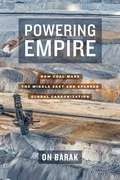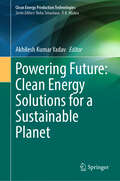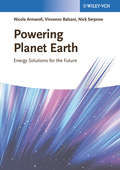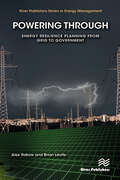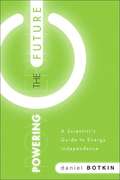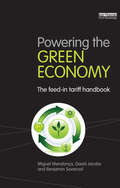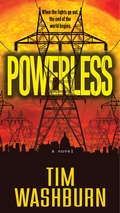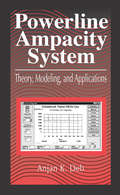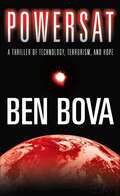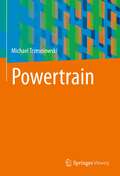- Table View
- List View
Power-Flow Modelling of HVDC Transmission Systems
by Suman Bhowmick Shagufta KhanThis book deals exclusively with the power-flow modelling of HVDC transmission systems. Different types of HVDC transmission systems, their configurations/connections and control techniques are covered in detail. Power-Flow modelling of both LCC- and VSC-based HVDC systems is covered in this book. Both the unified and the sequential power-flow methods are addressed. DC grid power-flow controllers and renewable energy resources like offshore wind farms (OWFs) are also incorporated into the power-flow models of VSC-HVDC systems. The effects of the different power-flow methods and HVDC control strategies on the power-flow convergence are detailed along with their implementation. Features: Introduces the power-flow concept and develops the power-flow models of integrated AC/DC systems. Different types of converter control are modelled into the integrated AC/DC power-flow models developed. Both unified and the sequential power-flow methods are addressed. DC grid power-flow controllers like the IDCPFC and renewable energy resources like offshore wind farms (OWFs) are introduced and subsequently modelled into the power-flow algorithms. Integrated AC/DC power-flow models developed are validated by implementation in the IEEE 300-bus and European 1354-bus test networks incorporating different HVDC grids. This book aims at researchers and graduate students in Electrical Engineering, Power Systems, and HVDC Transmission.
Power-Lined: Electricity, Landscape, and the American Mind
by Daniel L. WuebbenThe proliferation of electric communication and power networks have drawn wires through American landscapes like vines through untended gardens since 1844. But these wire networks are more than merely the tools and infrastructure required to send electric messages and power between distinct places; the iconic lines themselves send powerful messages. The wiry webs above our heads and the towers rhythmically striding along the horizon symbolize the ambiguous effects of widespread industrialization and the shifting values of electricity and landscape in the American mind. In Power-Lined Daniel L. Wuebben weaves together personal narrative, historical research, cultural analysis, and social science to provide a sweeping investigation of the varied influence of overhead wires on the American landscape and the American mind. Wuebben shows that overhead wires—from Morse’s telegraph to our high-voltage grid—not only carry electricity between American places but also create electrified spaces that signify and complicate notions of technology, nature, progress, and, most recently, renewable energy infrastructure. Power-Lined exposes the subtle influences wrought by the wiring of the nation and shows that, even in this age of wireless devices, perceptions of overhead lines may be key in progressing toward a more sustainable energy future.
Power-Switching Converters
by Simon Ang Alejandro Oliva Gary Griffiths Richard HarrisonSignificantly expanded and updated with extensive revisions, new material, and a new chapter on emerging applications of switching converters, Power-Switching Converters, Third Edition offers the same trusted, accessible, and comprehensive information as its bestselling predecessors. Similar to the two previous editions, this book can be used for a
Power-efficient System Design
by Preeti Ranjan Panda Krishnaiah Gummidipudi B. V. Silpa Aviral ShrivastavaThis book addresses power optimization in modern electronic and computer systems. Several forces aligned in the past decade to drive contemporary computing in the direction of low power and energy-awareness: the mobile revolution took the world by storm; power budgets forced mainstream processor designers to abandon the quest for higher clock frequency; and large data centers with overwhelming power costs began to play vital roles in our daily lives. Power optimization was elevated to a first class design concern, forcing everyone from the process engineer, circuit designer, processor architect, software developer, system builder, and even data center maintainer to make conscious efforts to reduce power consumption using myriad techniques and tools. This book explores power optimization opportunities and their exploitation at various levels of abstraction. Fundamental power optimizations are covered at each level of abstraction, concluding in a case study illustrating the application of the major techniques to a graphics processor. This book covers a comprehensive range of disparate power optimizations and is designed to be accessible to students, researchers, and practitioners alike.
Power-to-Gas: Technology and Business Models
by Markus Lehner Robert Tichler Horst Steinmüller Markus KoppeIncreased production of energy from renewable sources leads to a need for both new and enhanced capacities for energy transmission and intermediate storage. The book first compares different available storage options and then introduces the power-to-gas concept in a comprehensive overview of the technology. The state of the art, advancements, and future requirements for both water electrolysis and methanation are described. The integration of renewable hydrogen and methane into the gas grid is discussed in terms of the necessary technological measures to be taken. Because the power-to-gas system is very flexible, providing numerous specific applications for different targets within the energy sector, possible business models are presented on the basis of various process chains taking into account different plant scales and operating scenarios. The influence of the scale and the type of the integration of the technology into the existing energy network is highlighted with an emphasis on economic consequences. Finally, legal aspects of the operation and integration of the power-to-gas system are discussed.
Power-to-X in Regional Energy Systems: Planning, Operation, Control, and Market Perspectives
by Frede Blaabjerg Amjad Anvari-Moghaddam Shi You Sina GhaemiPower-to-X in Regional Energy Systems discusses the role of these technologies in achieving a carbon-neutral economy and the impact on the energy markets, with implications for electricity, gas, hydrogen, and ancillary services. It focuses on the challenges and benefits of implementing PtX technologies in regional-scale applications.Emphasizing the role of PtX technologies as enablers of sector coupling, the book provides a comprehensive understanding of how these technologies integrate and interact with the industry, transportation, and residential sectors. It describes the significance of PtX, optimal planning, and cost-effective operation of PtX technologies across different sectors and the impact of PtX devices on energy markets. The book considers investing in PtX technologies and contributing to the transition to a sustainable economy.The book will interest professionals and policymakers working in various energy sectors. Researchers and academics in electrical engineering, power systems, renewable energy, and energy economics will also find the content useful.
Powered Flight
by David R. GreatrixWhilst most contemporary books in the aerospace propulsion field are dedicated primarily to gas turbine engines, there is often little or no coverage of other propulsion systems and devices such as propeller and helicopter rotors or detailed attention to rocket engines. By taking a wider viewpoint, Powered Flight - The Engineering of Aerospace Propulsion aims to provide a broader context, allowing observations and comparisons to be made across systems that are overlooked by focusing on a single aspect alone. The physics and history of aerospace propulsion are built on step-by-step, coupled with the development of an appreciation for the mathematics involved in the science and engineering of propulsion. Combining the author's experience as a researcher, an industry professional and a lecturer in graduate and undergraduate aerospace engineering, Powered Flight - The Engineering of Aerospace Propulsion covers its subject matter both theoretically and with an awareness of the practicalities of the industry. To ensure that the content is clear, representative but also interesting the text is complimented by a range of relevant graphs and photographs including representative engineering, in addition to several propeller performance charts. These items provide excellent reference and support materials for graduate and undergraduate projects and exercises. Students in the field of aerospace engineering will find that Powered Flight - The Engineering of Aerospace Propulsion supports their studies from the introductory stage and throughout more intensive follow-on studies.
Powerfuels: Status and Prospects (Green Energy and Technology)
by Martin Kaltschmitt Ulf Neuling Nils BullerdiekPowerfuels are the subject of intense and often contentious current discussions within industry, research, politics, as well as the overall society. These discussions primarily revolve around the practical and technical feasibility of power-to-X processes and applications, their economic viability, the respective environmental benefits, the contribution to climate protection as well as the social acceptability. Thus, the primary aim of this book is to provide a comprehensive overview of various aspects, diverse considerations, and different perspectives regarding the future role and utilization of power-to-X pathways on a global scale. This encompasses the challenge of sourcing necessary educts / feedstock options, their conversion into different products and product groups, exploring the possibilities of using these electricity-based fuels / hydrocarbons in various markets, and establishing suitable framework conditions for viable and sustainable markets in the years to come. These objectives are achieved through a collection of papers contributed by experts actively engaged in various fields related to power-to-X.
Powerful Pulsed Plasma Generators: Research and Application (Springer Series on Atomic, Optical, and Plasma Physics #101)
by Victor Kolikov Alexander Bogomaz Alexander BudinThis book presents experimental and theoretical results on extremely powerful plasma generators. It addresses pulsed electrical mega-ampere arcs and the mechanisms of energy transfer from the arc into hydrogen, helium and air under pressures up to 250 MPa and currents up to 2 MA. Extreme plasma parameters and increased energy density in the arc were achieved. It was found experimentally that increasing the initial gas pressure to hundreds of MPa leads to improved arc stability, high efficiency of energy transfer from arc to gas, and plasma enthalpy growth. The data obtained data provides the basis for the development of electrophysical devices with high energy density, e.g. high intensity sources for visible, UV and X-ray irradiation for laser pumping, generators of high enthalpy plasma jets, and plasma chemical reactors.
Powerhouse: Inside a Nuclear Power Plant
by Charlotte WilcoxYou use electricity every day at home and at school, but do you know where it comes from? About twenty percent of our electricity comes from nuclear energy-energy released when the nucleus of an atom splits apart. To find out how power from tiny atoms of uranium turns into the power behind your light switch, step inside a nuclear power plant. In Powerhouse, author Charlotte Wilcox follows the process of creating electricity from nuclear fuel at Prairie Island, a nuclear power plant in Minnesota. Along the way, readers will learn about atoms, radiation, the problem of nuclear waste, and the future of nuclear power. Jerry Boucher's full-color photographs give a behind-the-scenes look at this important and controversial energy source.
Powering American Farms: The Overlooked Origins of Rural Electrification
by Richard F. HirshThe untold story of the power industry's efforts to electrify growing numbers of farms in the years before the creation of Depression-era government programs.Even after decades of retelling, the story of rural electrification in the United States remains dramatic and affecting. As textbooks and popular histories inform us, farmers obtained electric service only because a compassionate federal government established the Tennessee Valley Authority and the Rural Electrification Administration (REA) during the Great Depression of the 1930s. The agencies' success in raising the standard of living for millions of Americans contrasted with the failure of the greedy big-city utility companies, which showed little interest in the apparently unprofitable nonurban market. Traditional accounts often describe the nation's population as split in two, separated by access to a magical form of energy: just past cities' limits, a bleak, preindustrial class of citizens endured, literally in near darkness at night and envious of their urban cousins, who enjoyed electrically operated lights, refrigerators, radios, and labor-saving appliances.In Powering American Farms, Richard F. Hirsh challenges the notion that electric utilities neglected rural customers in the years before government intervention. Drawing on previously unexamined resources, Hirsh demonstrates that power firms quadrupled the number of farms obtaining electricity in the years between 1923 and 1933, for example. Though not all corporate managers thought much of the farm business, a cadre of rural electrification advocates established the knowledge base and social infrastructure upon which New Deal organizations later capitalized. The book also suggests that the conventional storyline of rural electrification remains popular because it contains a colorful hero, President Franklin D. Roosevelt, and villainous utility magnates, such as Samuel Insull, who make for an engaging—but distorted—narrative.Hirsh describes the evolution of power company managers' thinking in the 1920s and early 1930s—from believing that rural electrification made no economic sense to realizing that serving farmers could mitigate industry-wide problems. This transformation occurred as agricultural engineers in land-grant universities, supported by utilities, demonstrated productive electrical technologies that yielded healthy profits to farmers and companies alike. Gaining confidence in the value of rural electrification, private firms strung wires to more farms than did the REA until 1950, a fact conveniently omitted in conventional accounts. Powering American Farms will interest academic and lay readers of New Deal history, the history of technology, and revisionist historiography.
Powering Autonomous Sensors
by María Teresa Penella-López Manuel Gasulla-FornerAutonomous sensors transmit data and power their electronics without using cables. They can be found in e.g. wireless sensor networks (WSNs) or remote acquisition systems. Although primary batteries provide a simple design for powering autonomous sensors, they present several limitations such as limited capacity and power density, and difficulty in predicting their condition and state of charge. An alternative is to extract energy from the ambient (energy harvesting). However, the reduced dimensions of most autonomous sensors lead to a low level of available power from the energy transducer. Thus, efficient methods and circuits to manage and gather the energy are a must. An integral approach for powering autonomous sensors by considering both primary batteries and energy harvesters is presented. Two rather different forms of energy harvesting are also dealt with: optical (or solar) and radiofrequency (RF). Optical energy provides high energy density, especially outdoors, whereas RF remote powering is possibly the most feasible option for autonomous sensors embedded into the soil or within structures. Throughout different chapters, devices such as primary and secondary batteries, supercapacitors, and energy transducers are extensively reviewed. Then, circuits and methods found in the literature used to efficiently extract and gather the energy are presented. Finally, new proposals based on the authors' own research are analyzed and tested. Every chapter is written to be rather independent, with each incorporating the relevant literature references. Powering Autonomous Sensors is intended for a wide audience working on or interested in the powering of autonomous sensors. Researchers and engineers can find a broad introduction to basic topics in this interesting and emerging area as well as further insights on the topics of solar and RF harvesting and of circuits and methods to maximize the power extracted from energy transducers.
Powering Empire: How Coal Made the Middle East and Sparked Global Carbonization
by On BarakThe Age of Empire was driven by coal, and the Middle East—as an idea—was made by coal. Coal’s imperial infrastructure presaged the geopolitics of oil that wreaks carnage today, as carbonization threatens our very climate. Powering Empire argues that we cannot promote worldwide decarbonization without first understanding the history of the globalization of carbon energy. How did this black rock come to have such long-lasting power over the world economy? Focusing on the flow of British carbon energy to the Middle East, On Barak excavates the historic nexus between coal and empire to reveal the political and military motives behind what is conventionally seen as a technological innovation. He provocatively recounts the carbon-intensive entanglements of Western and non-Western powers and reveals unfamiliar resources—such as Islamic risk-aversion and Gandhian vegetarianism—for a climate justice that relies on more diverse and ethical solutions worldwide.
Powering Future: Clean Energy Solutions for a Sustainable Planet (Clean Energy Production Technologies)
by Akhilesh Kumar YadavThis edited volume explores the world of clean energy, diving into technological innovations and advancements. This book discusses the complexities of our energy landscape, providing comprehensive insights into renewable technologies and their environmental impacts. The need for renewable energy stems from various environmental, economic, and social concerns. The renewable energy sources such as solar, wind, hydro, and geothermal power offer sustainable alternatives to finite fossil fuels. They reduce greenhouse gas emissions, mitigate climate change, enhance energy security by diversifying the energy mix, and diminish dependence on imported fuels, thus decreasing geopolitical risks. Transitioning to clean energy production technologies also reduces air and water pollution, which is crucial for a sustainable future, ensuring environmental protection, economic prosperity, and social equity for present and future generations. Some of the key topics covered are solar energy utilization; efficiency and life cycle analysis of solar panels; nature-based energy generation; sustainability through biomass and biogas; nuclear energy; geothermal energy, among others. This book is an engaging read for students, academics, researchers, policymakers, and climate enthusiasts, offering valuable information to assist us in making informed decisions for a cleaner, greener future.
Powering Planet Earth: Energy Solutions for the Future
by Vincenzo Balzani Nicola ArmaroliIn their book Nicola Armaroli, Vincenzo Balzani and Nick Serpone uncover the background details associated with a transition to sustainable energy production that are routinely swept under the table in public discussions. They are not only concerned with the (alleged) advantages and disadvantages of any one energy generation technology from a technical viewpoint, but also with the ecological, economic, political and social consequences of an inevitable transition. In a highly readable manner aimed at an international audience, the authors introduce the often misused and sometimes abused term 'energy' and give a lucid account of the development of energy production from timber to nuclear energy and renewable energies. They compare various energy generation methods with respect to their efficiency and practicability for large-scale implementation and examine if, and how, these methods live up to the expectations and promises their proponents make. In addition, the authors juxtapose the political and economic prerequisites in different regions of the world that advance, or hinder, an energy turnaround. They round off their book by debunking the seventeen most popular myths often cited in discussions on energy issues. As a result, the authors provide ammunition for debate, underpin (and unsettle) opinions using facts, and challenge comfortable and popular chains of reasoning.
Powering Through: Energy Resilience Planning from Grid to Government
by Brian Levite Alex RakowThe threats to the electricity grid are on the rise at the same time as society is increasing its dependence on electricity for every aspect of our personal, social, and economic lives. We are accelerating that dependence – looking to the electrification of transportation and buildings as a way to stem the threats of climate change. Those threats have now arrived (in the form of more extreme weather, droughts, and wildfire) and they are joined by increasing threats from an aging grid and cyberattacks. The grid we rely on is experiencing increasingly vulnerable external forces. We aren’t helpless. Effective planning around these threats can dramatically reduce the havoc they engender on the electric grid. At every level, from a single building, to a city, to the electric grid and the federal government, steps can be taken to improve our resilience to threats to the electricity system. When those efforts are coordinated, their benefits multiply. This book aims to provide every level of decision-maker with tools and best practices for reducing the risk of and from electricity loss. It is written in non-technical language, with a focus on actionable, easily implemented steps.
Powering the Dream: The History and Promise of Green Technology
by Alexis MadrigalFew today realize that electric cabs dominated Manhattan's streets in the 1890s; that Boise, Idaho, had a geothermal heating system in 1910; or that the first megawatt turbine in the world was built in 1941 by the son of publishing magnate G. P. Putnam--a feat that would not be duplicated for another forty years. Likewise, while many remember the oil embargo of the 1970s, few are aware that it led to a corresponding explosion in green-technology research that was only derailed when energy prices later dropped.In other words: We've been here before. Although we may have failed, America has had the chance to put our world on a more sustainable path. Americans have, in fact, been inventing green for more than a century.Half compendium of lost opportunities, half hopeful look toward the future, Powering the Dream tells the stories of the brilliant, often irascible inventors who foresaw our current problems, tried to invent cheap and energy renewable solutions, and drew the blueprint for a green future.
Powering the Future: A Scientist's Guide to Energy Independence
by Daniel B. BotkinThe future of civilization depends upon the continuous availability of sufficient energy. But we're approaching the practical limits of some of the energy sources we depend upon most. What should be done? Few issues are as controversial. In Powering the Future, a leading scientist cuts through the controversy, presenting the facts about our energy needs, desires, and supplies and the environmental and human effects of obtaining and using energy. Dr. Daniel B. Botkin objectively assesses the true prospects, limitations, costs, risks, dangers, and tradeoffs associated with every leading and emerging source of energy, including oil, natural gas, coal, hydroelectric, nuclear, wind, solar, ocean power, and biofuels. Next, Botkin addresses the energy distribution system, outlining how it currently works, identifying its inefficiencies, and reviewing options for improving it. Finally, Botkin turns to solutions, offering a realistic, scientifically and economically viable path to a sustainable, energy-independent future: one that can improve the quality of life for Americans and for people around the world. THE FUTURE OF FOSSIL FUELS-- What can we realistically expect from oil, gas, and coal? WILL ALTERNATIVE ENERGY SOURCES REALLY MATTER? Running the numbers on solar, wind, biofuels and other renewables. MUST WE ALL WEAR SWEATERS AND LIVE IN CAVES? The right role for efficiency--and why energy minimalism isn't the solution. WHERE WE CAN START--AND WHAT WILL HAPPEN IF WE DON'T? No magic bullet, but there are sensible, realistic solutions.
Powering the Green Economy: The Feed-in Tariff Handbook
by Miguel MendoncaEffective policy is vital for creating greener economies, new jobs and industries, for securing energy supplies and for protecting the climate and environment. As renewable energy is fundamental to achieving all of these objectives, it too needs the best possible policy to drive it. Feed-in tariffs have proven to deliver the fastest, most cost-effective and inclusive deployment, by allowing anyone to sell renewable energy into the grid and get a long term, guaranteed return for it. This book, from authors who have spent years working on feed-in tariff design and advocacy, provides a broad and detailed resource on feed-in tariffs and other renewable energy support schemes. It shares many lessons on good and bad design and implementation, as well as discussing the challenges faced by policy, and renewable energy in general. Powering the Green Economy: - Situates renewable energy and feed-in tariffs within the context of the global moves towards a green economy - Provides an introduction to feed-in tariffs and brings developments in key countries around the world up to date - Investigates effective design for developed and emerging economies - Explores technical, social and political issues - Analyses other support schemes - Describes the barriers to renewable energy - Presents a blueprint for campaigning successfully for feed-in tariffs Written in a clear, practical style, this is a must-read for policymakers, businesses, investors, campaigners, academics, community groups and anyone concerned with creating successful and sustainable energy policy.
Powering the World's Airliners: Engine Developments from the Propeller to the Jet Age
by Reiner DecherFrom propellers to turbofans, this illustrated history of engines will be “of interest to modelers and aviation historians alike” (AMPS Indianapolis).The first efforts of man to fly were limited by his ability to generate sufficient power to lift a heavier-than-air machine off the ground. Propulsion and thrust have therefore been the most fundamental elements in the development of aircraft engines.From the simple propellers of the first airliners of the 1920s and 1930s, to the turboprops and turbojets of the modern era, the engines used in airliners have undergone dramatic development over a century of remarkable change. These advances are examined in detail by aeronautical engineer Reiner Decher, who provides a layman’s guide to the engines that have, and continue to, power the aircraft that carry millions of travelers across millions of miles each year. Decher also looks at the development of aero engines during the Second World War and how that conflict drove innovation and explains the nature of wing design, from the early twentieth century to the present.To enable an easy understanding of this intriguing subject, Powering the World’s Airliners is profusely illustrated, transporting readers back to the time of each major development and introducing them to the key individuals of the aero industry in each era. After reading this comprehensive yet engaging story of the machines that power the aircraft in which we fly, no journey will ever seem quite the same again.
Powerless
by Sam TranumThis is a book about India's energy shortage, its causes, and consequences. Powerless details how much coal, oil, gas, uranium, and power the country uses, and for what purposes. It examines the quantity of these things the country produces and where. The book looks at the sizes of the gaps between supply and demand, and how the country fills them with imports. It then discusses how the shortages and resulting imports affect the country's economy, businesses, and residents. After examining the current scenario, the author moves on to look at predictions for how fast demand and supply will grow, how big the shortages of natural resources might become in the next few years, and whether India is likely to be able--politically, logistically, and financially--to fill these gaps with imports. The book also looks at the environmental and health effects of India's growing energy use, and how efforts to mitigate these are likely to affect demand for coal, oil, gas, and uranium.
Powerless
by Tim WashburnWhen a disaster plunges civilization back into the Dark Ages, one man will do whatever it takes to reunite with his family in this apocalyptic thriller.It strikes without warning. A massive geomagnetic solar storm that destroys every power grid in the northern hemisphere. In Boulder, Colorado, weather technicians watch in horror as civilization collapses around them. Planes are falling out of the skies. Cars are dead. Pandemonium and terror grip the planet.As nuclear reactors across North America face inevitable meltdowns, the US President remains powerless in a heavily guarded White House. From London to Boston to Anchorage, there is no food, no water, no hope. It's every man for himself. . .and it will only get worse.Army veteran Zeke Marshall is the one man prepared to handle a nightmare like this. But when he tries to reunite with his family in Dallas—across a lawless terrain as deadly as any battlefield—he discovers there are worse things in life than war. And what he'll have to do to survive is unthinkable . . .
Powerline Ampacity System: Theory, Modeling and Applications
by Anjan K. DebCivilization's demands for electricity continue to grow, yet environmental, regulatory, and economic constraints often preclude the construction of new power plants and transmission lines. The challenge now faced by engineers, equipment manufacturers, and regulatory agencies is to find ways to maximize the capacity of existing power lines.Powerline Ampacity System is the first step in meeting that challenge. Along with developing a complete theory of transmission line ampacity, the author uses object-oriented modeling and expert rules to build a power line ampacity system. He describes new transmission line conductor technologies and power electronics FACTS devices that can take full advantage of a dynamic line rating system. He offers examples that clearly show the economic benefit of operating an interconnected transmission network that has a diverse mix of electricity generation sources. He also discusses - with examples - generator stability enhancement by dynamic line rating.
Powersat: A Thriller of Technology, Terrorism, and Hope (The Grand Tour)
by Ben BovaOil cartels and deadly terrorists threaten one man’s work to generate clean energy in this science fiction thriller by the six-time Hugo Award–winning author.Two hundred thousand feet up, things go horribly wrong. The experimental low-orbit spaceplane Astro falls to earth over a trail hundreds of miles long. In the wake of this disaster is the beginning of the most important mission in the history of space.Entrepreneur Dan Randolph is determined to provide energy to a desperate world. He dreams of an array of geosynchronous powersats, satellites which gather solar energy and beam it to generators on Earth, breaking the power of the oil cartels forever. But the wreck of the experimental spaceplane has left his company on the edge of bankruptcy.Worse, Dan discovers the plane worked perfectly right up until the moment that saboteurs knocked it out of the sky. And whoever brought it down is willing and able to kill again to keep Astro grounded. . . .Praise for Powersat“[Bova] supplies a suspenseful ride and plenty of high-tech hardware.” —Publishers Weekly“Tom Clancy-like danger and intrigue!” —Amazing“A classic guy’s tale. . . . Bova is a spare writer who nevertheless crafts the perfect voice for each of his characters.” —San Antonio Express-News
Powertrain
by Michael TrzesniowskiIn this book, the reader learns the essential differences to the passenger car through the analysis divided according to assemblies. This gives him the tools to apply the detailed knowledge acquired to the design and development of competition vehicles. In the case of internal combustion engines, the focus is on performance-enhancing measures for racing vehicles. From the choice of the number of cylinders to the intake system to the exhaust system, the lever can be applied to every assembly. For electric drives, the traction battery, cell selection, cooling and operating strategy are considered in more detail. Energy recovery systems are an interesting enhancement for hybrid vehicles and all-electric powertrains, especially in strategic considerations for racing. Finally, gearboxes are needed independently of the drive source, albeit matched to it, so that the full potential can be exploited. The detailed, in-depth presentation makes this work just as suitable for the interested motorsport enthusiast as it is for the engineer in the field who is addressing the issues surrounding race car powertrains. The formula material is prepared in such a way that the book can also be used as a reference work.
